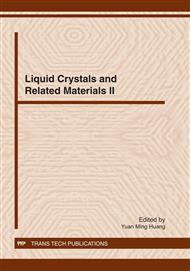p.47
p.51
p.55
p.59
p.63
p.67
p.71
p.75
p.79
Effects of the Heat Treatment on the Mechanical Properties of a Novel Thermotropic Liquid-Crystalline Polymer Fiber
Abstract:
Thermotropic liquid-crystalline polymers (TLCPs) have aroused wide public concern which is attributed to their high strength, stiffness, chemical resistance and perfect dimensional stability as high-performance engineering materials. Vectran heat treated after melt spinning is a representative commercial aromatic copolyester fiber. In this study, a novel TLCP melt-polymerized with 4,4’-diphenyloxide dicarboxylic acid (DODA), 4-acetoxybenzoic acid (ABA), hydroquinone diactate (HQA), 2,6-naphthalene dicarboxylic (NDA) and terephthalic acid (TA) were melt spun into fibers and heat treated to enhance the breaking strength and Young’s modulus. Intermolecular mechanical elements slipped between 120-130 °C and crystallization or the conformational rotations occurred along the extended polymer chain. For this new TLCP fiber, the optimal heat treatment temperature was 260 °C and the suitable heat-treatment time was over 48 hours. The breaking strength, Young’s modulus and breaking elongation of the as-spun fiber were improved from 1.58GPa, 45.21GPa and 1.97% to 3.20GPa, 133.44GPa and 2.42% respectively after heat treatment.
Info:
Periodical:
Pages:
63-66
Citation:
Online since:
November 2011
Authors:
Keywords:
Price:
Сopyright:
© 2012 Trans Tech Publications Ltd. All Rights Reserved
Share:
Citation:


